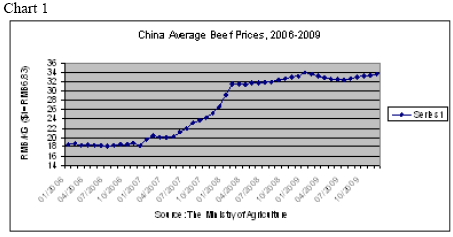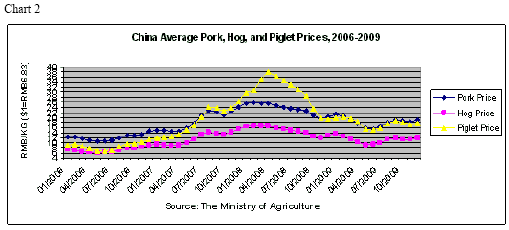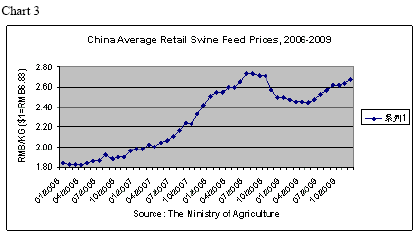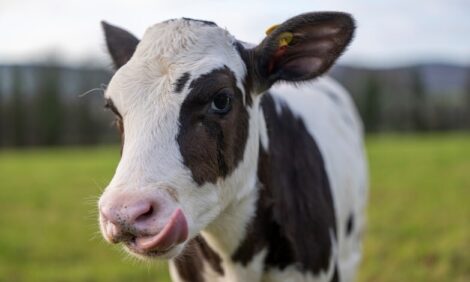



China - Livestock and Products Semi-Annual Report 2010
Chinese pork imports will rebound from sharply lower levels inspite of higher domestic production and beef production in 2010 will fall due to a continued fall in the country's cattle herd, according to Michael Woolsey and Jianping Zhang in the latest GAIN Report from USDA Foreign Agricultural Service.
Report Highlights
FAS Beijing forecasts China’s beef production in 2010 will fall five per cent due to a continued fall in China’s cattle herd. High Chinese beef prices will boost beef imports, with beef imports forecast to jump one-third to 30,000 metric tons (MT). Beef exports are forecast to slide 25 per cent to 28,000 MT due to high Chinese beef prices. Rising swine and productive sow inventories and a stronger Chinese economy in 2010 will boost Chinese pork production four per cent to 50.6 million MT. Despite higher domestic production, Chinese pork imports will rebound from sharply lower levels in 2009 to 220,000 MT, fueled by stronger demand in 2010. China’s live swine and pork exports in 2010 are forecast to increase four and three per cent respectively to 1.78 million head and 240,000 MT, bolstered by higher sales to Hong Kong.
Executive Summary
FAS Beijing forecasts China’s total meat production in 2010 will rise another three per cent to 77.5 million metric tons (MMT) following a three per cent increase in the previous year, as higher pork production more than offsets further declines in Chinese beef supplies.
China’s beef production is estimated to continue falling to 5.5 MMT in 2010, down five per cent from the year before, as comparatively low farm returns dampen enthusiasm for raising beef cattle. Post forecasts China’s 2010 beef imports will increase nearly one-third to 30,000 MT, encouraged by continued high prices in the Chinese beef market. Significantly higher quantities of imported beef continue to move through gray channels. Traders estimate these imports – primarily from Brazil and the United States – topped 100,000 metric tons in 2009. Meanwhile, reduced supplies and high prices will drive further declines in Chinese beef exports to 28,000 metric tons, down from 38,000 metric tons in 2009.
High swine and productive sow inventories will boost China’s pork production four per cent to an estimated 50.6 MMT in 2010. Pork imports will rebound 11 per cent to 220,000 from sharply lower levels in 2009. The gains will be fueled by an expected resumption in shipments from the United States and a stronger economy. Post forecasts China’s live swine and pork exports in 2010 to rise four and three per cent respectively to 1.78 million head and 240,000 MT, boosted by an improving economy in key markets including Hong Kong.
Cattle and Beef
Cattle and Beef Production Continues to Slide
FAS Beijing forecasts Chinese beef cow beginning stocks will fall three per cent to 46.5 million head in 2010, with calf production in 2010 expected to decline four per cent to 41 million head. Despite high beef prices, cattle supplies continue to slide due to comparatively poor farm returns, driving beef production down an estimated five per cent to 5.5 MMT in 2010.
The comparatively low returns compared to swine and poultry, longer production period, combined with expected higher feed prices and production costs in 2010 will continue to dampen cattle farmer interest in expanding placement. Cattle farmers point to the predominant cattle marketing pattern, where intermediaries do the bulk of the purchasing from backyard farmers and keep farm returns low, as a significant factor in low enthusiasm for raising cattle. Although the Chinese government introduced new subsidies in 2009 to boost local beef supplies and improve herd quality, these efforts are considered too modest to stem the decline in China’s beef cattle herd.
Chinese Beef Consumption Weakened by High Prices
Lower domestic beef production in 2010 will continue to support higher domestic beef prices and lower consumption, as higher imports only partially offset the decline in local supplies. The 2009 average beef price was RMB33.09 ($4.84) per kilogram, a four per cent increase from the previous year, and nearly an 80 per cent increase since 2006 (see chart 1). Meanwhile, prices of substitute meats continued to fall. 2009 average pork prices dropped 22 per cent to RMB18.28 ($2.68) per kilogram, while average broiler prices slid five per cent to RMB13.78 ($2.02) per kilogram, making these meats an even better bargain in 2009 relative to beef. The price gap is expected to widen further in 2010.

Recovering Dairy Industry Drive Breeding Dairy Cow Imports
China’s breeding cow imports in 2009 nearly doubled to 36,000 head fueled by strong demand from dairy operators as the industry gradually recovers from the nationwide melamine crisis in September 2008. The imports are needed to begin replacing some of the more than one million dairy cows that were eliminated from China’s dairy herd following the melamine scandal Total sales are estimated to rise 25 per cent in 2010 to 45,000 head. Australia and New Zealand will continue to dominate live cattle supplies to China as imports of North American cattle are banned due to BSE.
Beef Imports Continue Strong
While a tiny share of total consumption, China’s beef imports continue to rise rapidly, and are forecast to jump 30 per cent this year to 30,000 metric tons. In 2009, these sales increased more than threefold to 23,000 metric tons, with shipments from Australia, Uruguay and New Zealand all more than doubling from the year before. While Australia is the top supplier, imports from Uruguay are rising the fastest due to competitive pricing on muscle cuts. These imports topped 6,000 metric tons and strong gains are expected in 2010. Meanwhile, traders reported significantly higher beef imports through gray channels in 2009, with the great majority of shipments originating from Brazil and the United States. Overall, these imports are estimated at over 100,000 metric tons in 2009.
Lower Domestic Cattle and Beef Supplies Dampen Exports
Almost all China’s live cattle exports are destined to Hong Kong and Macau for slaughter, a tradition of local consumers’ preference for fresh meats. Post forecasts lower China cattle supplies will reduce 2010 exports to 30,000 head, down six per cent from the year before. The continued decline in China’s beef cattle herd will also dampen beef supplies available for export in 2010. These shipments are forecast to decline 26 per cent to 280,000 MT.
Swine and Pork
Modest Gain in Chinese Pork Production Expected in 2010
High swine and productive sow inventories in early 2010 and a strong economy will support a continued rise in Chinese pork production this year. Overall, Post projects pork output will rise 4 per cent to 50.6 million tons. Total pig crop production is forecast up 3 per cent to 668.5 million head in 2010. The national end-of-year swine and productive sow inventories in 2009 rose 1.32 per cent and 0.64 per cent respectively to 469 million and 49.1 million head from the previous year, significantly higher than government target levels. At the moment, the Chinese government guidance for the swine industry is to control total swine inventory at 410 million head with productive sows accounting for not more than 10 per cent, well below current levels (see table 1). The Chinese government continues to urge domestic swine producers to avoid expanding placements in order to prevent oversupplies.
| Table 1: China Monthly Swine and Productive Sow Inventories in 2009 (1,000 Head) | |||
| Month | Total Swine | Productive Sows | Sow Ratio to Swine |
|---|---|---|---|
| January | 456,160 | 50,100 | 10.98 |
| February | 445,940 | 49,870 | 11.18 |
| March | 448,610 | 49,420 | 11.02 |
| April | 454,890 | 49,220 | 10.82 |
| May | 453,250 | 48,800 | 10.77 |
| June | 447,200 | 48,300 | 10.80 |
| July | 450,060 | 48,060 | 10.68 |
| August | 458,160 | 48,160 | 10.51 |
| September | 465,160 | 48,400 | 10.41 |
| October | 469,210 | 48,750 | 10.39 |
| November | 465,900 | 48,700 | 10.45 |
| December | 469,000 | 49,100 | 10.47 |
| Source: The Ministry of Agriculture | |||
However, reducing China’s pig crop will be difficult as the current sow inventory is considered more productive than the same time last year, as farmers increased slaughter of old or low-yield sows in late 2008 and early 2009 before prices began to fall. Sows are most productive in early years (one to four litters), so the younger sow crop in 2010 compared to 2009 will support higher production this year. Swine producers are expected to maintain high sow levels despite a risk of oversupply.
Larger-sized hog farms (with annual slaughter at or above 50 head) are becoming more important as less efficient backyard operators continue to decline as a share of total production. To encourage larger-sized hog farm development, the government provided subsidies worth RMB2.5 billion ($366 million) in 2009 targeted to improve hog raising conditions in these facilities. Overall, the Ministry of Agriculture has reported farms of 50 hogs or more now account for almost 60 per cent of total slaughter, up from less than half in 2007. These larger farms are more likely to practice disease control measures and operate under contracts with slaughter facilities, making returns more predictable. Post expects further gains in larger farms as a share of total production in 2010.
Government subsidies to increase China’s sow herd, introduced in the wake of the 2007 blue ear disease outbreak, have also played a significant role in increased production. The subsidy grew from RMB50 ($7.32) per head to RMB100 ($14.64) in 2009, successfully boosting the sow herd from under 40 million to nearly 50 million animals. However, while the subsidy was applied nationwide initially, only certain provinces have continued this in 2010. Separately, a sow insurance subsidy of RMB60 ($8.80) per head has continued this year.
Gradual improvement in animal genetics is also being observed, with modest government subsidies introduced in 2009. According to the “Notice of 2009 High-Quality Livestock Breeding Stocks Subsidy Programme, and Implementation Guidance by the Ministry of Finance”, the central government provided RMB29.6 million ($4.34 million) subsidising breeding stock improvement in Hubei Province (one of the largest producers) which continues into 2010 covering nineteen cities and counties. Each productive sow was subsidised RMB40 ($5.87) annually for two litters with each litter using two straws of high-quality boar semen. Double-digit gains in swine feed is also improving efficiency. In 2009, swine feed production was estimated at 51.03 MMT, up 11.5 per cent from the previous year.
Providing steady and abundant supplies of affordable pork is considered important for social stability, as 65 per cent of China’s animal protein comes from pork. To stabilize prices and ensure sufficient farmer returns, the government implemented a market intervention scheme in 2009 whereby the central government purchases pork for state reserves whenever the pork/grain price ratio falls below 6. Since introduction, the government has announced purchases once, taking 120,000 MT of pork off the market in June 2009. Following the purchase, prices picked up immediately. As a result, sow inventory began rebounding in the latter half of 2009.

Rising feed costs remain a threat to hog producer returns. According to the China National Grain and Oil Information Center, domestic corn production declined 1.8 per cent to 163 MMT in 2009 because of severe drought. On 12 October 2009 the State Council decided at its Standing Committee meeting to continue subsidising corn, soybean, and rape seed procurements for central reserves at protective prices. On 1 December 2009, China suspended auction of temporarily reserved corn in producing areas because of lower production. In January 2010, China announced the corn procurement protective price at RMB 1,500 ($219.62) per ton, the same as the previous year. At the same time, the government allowed some feed companies involve in corn procurement for their own use beside COFCO, a state monopoly for serial and oil imports and exports. Less supply and more competition in handling procurement will most likely keep corn prices strong in 2010.

Pork Consumption Continues to Rise
Post forecasts Chinese total pork consumption in 2010 to rise nearly four per cent to 50.6 MMT, following a five per cent increase in the previous year. Strong consumer preference for pork as the meat of choice, projected robust economic growth in 2010 at nearly 9 per cent, and low pork prices will all factor into further consumption gains. Consumer demand will be further bolstered by the large number of migrant workers (mostly farmers) who had lost their jobs in cities in 2008 and returned to the farm, are now back at work in urban areas as consumers of pork rather than producers.
Pork Import Ban Lifted But Trade Yet to Resume Due to Additional Certification Requirement for A-H1N1
US pork implemented in late April in response to human A-H1N1 cases in the United States. However, on 3 December 2009, AQSIQ/Import and Export Food Safety Bureau notified FAS Beijing in its No. 1175 letter that it will require additional A/H1N1 influenza certification for all pork exports to China as follows: “Through monitoring and ante-mortem quarantine, the source swine population of pig products is not infected with A/H1N1 influenza. Pork products are not contaminated by the A/H1N1 influenza.” The United States maintains the certification statements are unnecessary since current US certification is sufficient to ensure safe trade. Bilateral negotiations are continuing.
Chinese Pork Imports Reduced by Higher Chinese Production and A-H1N1 Import Ban
Higher Chinese pork production in 2009 lowered import demand for most of the year, well more than offsetting strong import levels toward the end of 2009 as prices rebounded. Overall, China’s pork imports (including offals, casings, and trans-shipments through Hong Kong) in 2009 declined by roughly one-third to 650,000 metric tons. Since China banned US pork after 27 April 2009 due to human cases of A-H1N1, shipments from the EU became more important in 2009, accounting for well over half of sales. Canadian pork comprised most of the remainder. 2009 shipments from the United States totaled just over 100,000 metric tons, down from 349,000 metric tons in 2008.
Fueled by a stronger Chinese economy in 2010, Post projects China’s pork imports will rebound in 2010 despite continued gains in Chinese production. An expected resumption in imports from the United States in 2010 will also support higher imports. While offals are the primary pork import, there is also strong interest in imported leg and shoulder meat, picnics and ribs for use by food processors and foodservice operators.
Lower Live Swine Imports due to A-H1N1 Import Ban
China’s imports of live breeding swine fell from over 10,000 head in 2008, to under 3,000 head last year, due to China’s A-H1N1 ban on swine from North America. North America accounts for nearly all China’s live hog imports. Interest among Chinese producers for US hogs remains strong. However, following an expected market opening in early 2010 as H1N1 concerns continue to wane, sales could be limited compared to 2008 by an oversupply of sows and expiration of sow subsidies in most Chinese provinces. Long term, China’s need for swine genetic improvement will continue to boost sales for US hogs, as the quality characteristics of US breeding swine are well-known and widely accepted by Chinese swine producers
Steady Growth in Live Swine and Pork Exports
China only exports live swine to Hong and Macau for slaughter. As Hong Kong’s economy is recovering from an impact of the world financial crisis, Hong Kong’s demand for fresh pork from hogs slaughtered in Hong Kong is expected higher in 2010. Post expects China’s total live swine exports to increase nearly four per cent to forecast 1.78 million head in 2010.
China’s total pork exports in 2010 are forecast to increase three per cent to 240,000 MT fueled by higher demand in export markets. Southeast Asian countries or areas are China’s main export markets with Hong Kong market accounting for over 50 per cent of China’s total exports. Post expects exports to Japan will decline in 2010, dampened by higher Japanese production and stocks.
Further Reading
| - | You can view the full report by clicking here. |
March 2010


